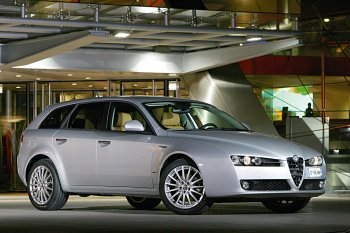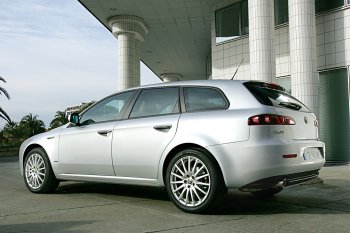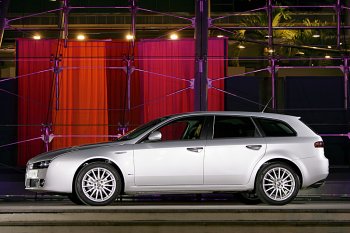|
Powerful, elastic engines that respect the environment
|
|
At its launch,
the Alfa 159 Sportwagon is equipped with three petrol and
three turbodiesel engines, all combined with new mechanical
six-speed gearboxes, with short strokes, precise engagement
and low loads. A 1.8 litre engine delivering 140 bhp will be
available soon after the launch, while automatic
transmissions and a Selespeed robotised gearbox will also be
proposed on some versions, all with six speeds.
The 3.2 JTS (260 bhp), 2.2 JTS (185 bhp) and 1.9 JTS (160
bhp) were developed to respect the brief from the Alfa Romeo
engineers and represent the brand’s interpretation of the
direct injection petrol engine, which translates into
enjoyable driving and high performance for the customer. The
three engines adopt the direct injection JTS (Jet Thrust
Stoichiometric) combustion system, which produces brilliant
engine performance. The 3 engines deliver the quality one
expects from Alfa Romeo, having been fine-tuned on the
Balocco test track, while final assembly takes place in the
Alfa plant in Pomigliano. All the JTS engines obviously meet
Euro 4 limits. The Alfa 159 Sportwagon is also available
with three Multijet turbodiesel engines, the 1.9 8v JTDm
(120 bhp), 1.9 16v JTDm (150 bhp) and the new 2.4 20v JTDm
(200 bhp), which guarantee excellent power and torque
deliveries in all driving conditions, combined with low fuel
consumption. They are all combined with 6-speed gearboxes
(including the automatic transmission that will be available
on the 150 bhp 1.9 JTDm after the launch), true jewels of
automotive engineering that confirm Fiat Auto’s leadership
in this field. When it developed the Multijet system, the
Fiat Group set its stamp on the diesel engine market. The
three Multijet engines of the Alfa 159 Sportwagon obviously
respect Euro 4 limits, and incorporate a DPF (particulate
trap) that eliminates fine dust in line with the limits
currently envisaged for future Euro 5 legislation. It is a
‘for life’ system that does not need to be regenerated with
additives, and will be eligible for tax incentives.
The new 260 bhp 3.2 JTS V6
The Alfa Romeo ‘cuore sportive’ really beats in the new V6
3.2 litre petrol engine, which delivers 260 bhp. It
represents a significant departure from Alfa Romeo’s
previous V6 engine, as well as its natural evolution. The
new JTS engine is capable of a power delivery of 260 bhp (20
bhp or 8% more than the previous 3.2 V6 Q4); peak torque of
322 Nm at 4,500 rpm (+33 Nm, an increase of more than 11%);
a specific power of 60 kW/l and specific torque of 100 Nm/l;
a significant increase in torque at low speeds to improve
the smooth delivery (approximately 30 Nm more than the
previous 3.2 V6 engine, starting from 1500 rpm); maximum
revs of 7,200 rpm; minimal maintenance (hydraulic tappets
and timing gear with chain drive); low weight (aluminium
cylinder head and crankcase); and Euro4 exhaust emissions
limits. With this equipment, the Alfa 159 Sportwagon can
reach a top speed of 237 km/h and accelerate from 0 to 100
km/h in 7.2 seconds.
Main technical features
The new 6-cylinder engine of the Alfa 159 Sportwagon
continues the strategy begun with the 4-cylinder engines,
and adopts the JTS (Jet Thrust Stoichiometric) direct
injection system. This is an original Alfa Romeo concept
that injects the fuel directly into the combustion chamber
with a stoichiometric mixture optimised to enhance
performance, but also guarantees low consumption and respect
for the Euro4 emissions limits.
Numerous important components have been designed from
scratch and are exclusive to the Alfa Romeo V6 engine. To
start with, the cylinder head is aluminium and has 4 valves
per cylinder, 2 camshafts per bank with the ‘Twin Phaser’
continuous variable valve timing (intake and exhaust)
already adopted on Alfa Romeo 4-cylinder engines and now
applied on a 6-cylinder engine for the first time. Variable
valve timing allows the phase angle on both cams to be
varied by 50°, maximising performance on the one hand,
because the best phase can be chosen at all engine speeds,
and reducing consumption and emissions with partial loads on
the other.
At the same time it is possible to optimise the volumetric
efficiency of the engine over the whole operating range,
exploiting the degrees of freedom offered by variable valve
timing: this means a very favourable torque curve, with 90%
of peak torque available from 1800 rpm (290 Nm) and
maintained over a broad range (from 1800 rpm to 6250 rpm).
The valves are controlled by a roller finger system, with
low mechanical dissipation, and hydraulic uptake of tappet
play. Another peculiar feature is the camshaft drive system
which uses a primary chain that transmits the drive to the
heads via two secondary chains. Tension is provided by
automatic hydraulic tensioners which need no maintenance at
all during the life of the engine.
The high pressure fuel pump of the direct injection system
is mounted on the cylinder head, driven by a camshaft,
maintaining the pressure of the injected fuel at 120 bar by
a built-in pressure regulator. The inlet ports and
combustion chamber assembly are designed to optimise the
air-fuel mixture, to achieve the correct turbulence of the
inlet air, forming a homogeneous mixture, for stable,
complete combustion that produces fewer pollutants. The four
valves per cylinder with diameters of 33.4 mm on the inlet
and 28.4 mm on the exhaust guarantee suitable permeability
to enhance engine performance. The volumes and port geometry
of the aluminium inlet casing have also been adapted to the
high air delivery of the high revs to enhance performance.
The electronic throttle assembly with a 72 mm throttle valve
is mounted on this casing. And finally, the compression
ratio of 11.25:1 guarantees excellent engine performance
even with regular 95 octane fuel.
Briefly, the main technical features that distinguish the
new 3.2 V6 engine from the previous V6 engine are:
• twin overhead camshaft with low friction drive;
• direct petrol injection;
• double continuous variable valve timing on the inlet and
exhaust;
• cylinder head in light aluminium alloy;
• hydraulic tappets with automatic play uptake;
• crankcase in light aluminium alloy;
• maintenance-free timing gear drive chain;
• Poly V automatic tensioner belt to drive the engine
accessories;
• throttle valve with electronic drive-by-wire activation;
• single ignition coils;
• low specific consumption and emissions;
• EOBD;
• 4 lambda probes to control emissions;
• double knock sensor to improve knock sensitivity and to
optimise peak performance;
• high performance exhaust manifold with built-in
pre-catalysts;
• minimum maintenance;
• Euro 4 emissions.
The 3.2 V6 Q4 engine features an exhaust system that
envisages a first group of catalysing elements relatively
close to the cylinder heads to reduce the emissions level at
the start of operation. Two catalysts under the floorpan and
four lambda probes complete the system, so that the engine
respects Euro 4 limits without adopting special systems such
as secondary air or electric heating. Another feature of the
3.2 V6 Q4 engine is the direct injection system (the fuel is
supplied directly to the combustion chamber) whose main
advantage is that it improves evaporation and this increases
the engine’s volumetric efficiency. As a result, the supply
of air and petrol is both denser and colder, which allows
the compression ratio to be increased to 11.25, even if Euro
Super petrol is used, with an octane index of 95 RON; a high
compression ratio is useful because it makes it possible to
increase both the performance and the energy efficiency of
the engine.
And ignition is provided by a single sparkplug per cylinder.
Direct injection combined with 4-valve-per-cylinder geometry
creates a mix that tends to be more concentrated at the
centre of the combustion chamber. The ignition system
envisages a single ignition coil per cylinder.
|

 |
|

 |
|
The 185 bhp 2.2 JTS and the 160 bhp 1.9 JTS
The 4-cylinder engines of the Alfa 159 Sportwagon are
extremely light because they have aluminium cylinder heads
and crankcases (they are approximately 20 kg lighter than
the engines they replace). The timing gear control is
particularly evolved, featuring a system of rocker arms and
rollers, which significantly reduces dispersion due to
friction in the cylinder head, and the ‘Twin Phaser’
continuous variable valve timing system on the intake and
exhaust valves, which optimises power output, torque and
consumption.
The 2.2 JTS delivers 136 kW (185 bhp) and peak torque of 230
Nm (23.4 kgm) at 4,500 rpm, taking the car to a top speed of
220 km/h and accelerating from 0 to 100 km/h in 9.0 seconds.
Torque is also excellent on the 1.9 JTS (190 Nm – 19.4 kgm
at 4,500 rpm), and 88% is already available at 2,000 rpm.
And with a power delivery of 118 kW (160 bhp,) the brilliant
1.9 JTS has a top speed of 210 km/h.
Main technical features
To start with, the Twin Phaser system adopts new cam ‘lobes’
which allow the phase angle to be varied by 50° on both
axes; this makes it possible to improve performance on one
hand because the best phase can be chosen at all engine
speeds, and to reduce consumption and emissions with partial
loads, by the so-called Miller cycle. This combustion
system, which is based on the postponed opening and closing
of the inlet and exhaust valves – extends the expansive
phase (converting more heat into energy), guarantees
internal EGR (by preventing the release of the last exhaust
gases, full of unburned particles) and postpones the closure
of the inlet valve (reducing pumping losses).
Another peculiar feature of the 2.2 and 1.9 JTS engines that
equip the Alfa 159 Sportwagon is the camshaft drive system
which uses a chain; unlike a conventional belt drive, this
system has the advantage of not needing to be replaced
during the lifespan of the engine. And to guarantee the
performance one expects of an Alfa Romeo, the timing
diaphragm has also been reviewed, adopting larger profiles
which have made it possible to achieve a maximum power
output of 6500 rpm (the system is fine-tuned to operate at
over 7,000 rpm, the maximum rev speed allowed by the
electronic speed limiter).
That is not all. To achieve the best volumetric efficiency,
the maximum lift reaches 10.3 mm, while to enhance
vibrational and acoustic comfort, the engine is equipped
with two counter-rotating balancer shafts which virtually
eliminate the second degree alternate forces that are
typical of straight-4 engines. And the generous power
delivery of the engine (80 bhp/l on the 2.2 JTS) made it
necessary to adopt sodium-cooled exhaust valves.
The combustion chamber is shaped like a roof with four
valves per cylinder: with a bore of 86 mm, the large inlet
valves measure 35.3 mm and the exhaust valves 30.3 mm,
guaranteeing excellent permeability to enhance engine
performance. And, in spite of the stroke of 94.6 mm, in
order to limit the overall height of the engine, the
engineers have modified the piston height, achieving a
compression value of just 28 mm, which is excellent in view
of the high power delivery.
Where the exhaust, injection and ignition systems are
concerned, the two 4-cylinder JTS engines both adopt the
strategies and features illustrated for the new 3.2 V6 Q4
engine.
The 200 bhp 2.4 JTDm 20v
Derived from the familiar 2.4 JTD 20 valve ‘Common Rail’
engine, the new engine has 5 cylinders in line and is the
most powerful engine in the JTD multivalve Multijet family,
with a specific power of 84 bhp/litre. The new engine offers
numerous advantages. First of all, it is appreciably quieter
during the heating stage, depending on the rev speed and
ambient temperature. It is also extremely powerful (147 kW -
200 bhp at 4000 rpm), with a generous torque (400 Nm – 40.8
kgm at 2000 rpm).
There are four valves per cylinder, activated via hydraulic
tappets and rocker arms by the twin overhead camshaft.
Several changes were made to the new turbodiesel engine to
boost performance and engine torque at low speeds, and to
eliminate noise and vibration. For example, the ‘Common
Rail’ system adopted on the 200 bhp 2.4 JTDm 20v envisages
two new automatic control strategies for the setting and
balance of the injected diesel fuel, to reduce noise and
vibration.
The engine includes a number of new components, such as the
cylinder head with small stem inlet valves to increase the
quantity of inlet air, con rods of fractured steel and a new
shape that increases mechanical resistance to the strong
stress created by the increased power, an inlet manifold
fitted with a throttle valve on one of the two inlet ports
of the cylinders to control the turbulence of the air
entering, a throttle valve to prevent shaking if the engine
stalls, and an intercooler that is highly efficient thanks
to its shape and position in the car, to guarantee the
optimal temperature and density of the inlet air.
The electronic EGR exhaust gas cooling system has also been
modified; the lubricating circuit has a new oil pump and an
external air/oil heat exchanger to cool the oil, while the
water pump on the cooling circuit is also new. In other
words, a long list of improvements and changes that have
produced a reliable, powerful engine which is sparing on
fuel. Excellent results, achieved thanks to different engine
control settings, an increase in the direct injection
pressure to 1600 bar, and new turboblower settings. The
turboboost is provided by a turboblower with a variable
geometry turbo that helps to improve the power delivery, but
also generates very high torque even at low engine speeds.
In fact, 90% of peak torque is available between 1750 and
3500 rpm. These figures translate into extremely enjoyable
driving and brilliant performance: the Alfa 159 Sportwagon
has a top speed of 226 km/h and accelerates from 0 to 100
km/h in 8.6 seconds. Fuel consumption remains low (7 l/100
km in the mixed cycle).
A new 6-speed sequential automatic transmission will also be
available soon with the new 200 bhp 2.4 JTDm 20v engine, a
compact light device that incorporates the control unit in
the gearbox, and was designed paying particular attention to
consumption. On the one hand, the use of low friction oil
boosts efficiency, while on the other, the sixth speed has
been designed particularly for use on the motorway.
The 150 bhp and 120 bhp 1.9
JTDm
Both have 4 cylinders in line. The first is a 16-valve unit
that delivers 150 bhp (110 kW) at 4,000 rpm and peak torque
of 320 Nm (32.6 kgm) at 2,000 rpm; the second has 8 valves
and delivers 120 bhp (88 kW) at 4,000 rpm and peak torque of
280 Nm (28.6 kgm) at 2,000 rpm. Changes were made to both
engines to boost performance and engine torque at low
speeds, and to reduce noise and vibration. For example, the
Common Rail system includes two new strategies for
automatically calibrating and balancing the diesel fuel
injected, so as to lower noise and reduce vibration. That is
not all. The special features of the Alfa Romeo engine
include a variable geometry turboblower with a special rotor
that increases torque at low speeds (for the 1.9 JTDm 16v),
and an inlet manifold with a throttle valve on one of the
two inlet ports of the cylinders to control inlet air
turbulence (for the 1.9 JTDm 16v engine).
Equipped with the 150 bhp 1.9 JTDm engine, the Alfa 159
Sportwagon reaches a top speed of 208 km/h, and accelerates
from 0 to 100 km/h in 9.6 seconds (the values for the 120
bhp 1.9 JTDm are 190 km/h and 11.2 seconds respectively). In
spite of this brilliant performance, fuel consumption is
limited: 6.1 l/100 km on the mixed cycle (6 l/100 km for the
120 bhp 1.9 JTDm). Both the 200 bhp 2.4 JTDm 20v and the 150
bhp 1.9 JTDm will soon be available with a 6-speed automatic
gearbox and torque converter, fitted with a conventional
control on the tunnel plus the option of sequential controls
on the steering wheel. |
|